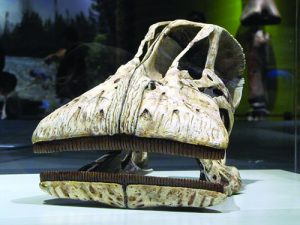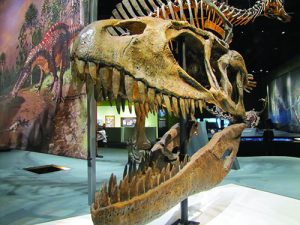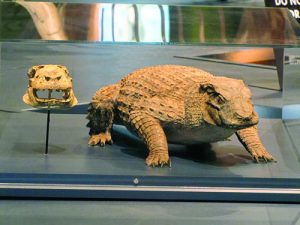
New types of dinosaurs are being discovered faster than ever before. Most are in the southern continents of Africa and South America and they include some of the biggest and strangest dinosaurs known.
Often quite different from their more familiar North American counterparts, including the list of state dinosaurs, and adorned with bizarre frills, bumps, dorsal sails, and crests, these new southern “terrible lizards” are changing many of our perceptions about dinosaurs.

As an example, consider the now-diminished status of the iconic Tyrannosaurus rex, the fiercest North American predator. The most widely recognized of all dinosaurs, T. rex had long been considered the biggest, baddest carnivore ever to walk the Earth. But now it seems that T. rex, whose name loosely means “king of the tyrant lizards,” is not really the king after all. It has recently been surpassed in both size and probable ferocity by Giganotosaurus from South America and Spinosaurus from Africa.
Dynamic Dinosaur Discoveries
Digging for dinosaurs in the Southern hemisphere is the latest chapter in dinosaur paleontology, a discipline that began in the late 1800s when dinosaur fossils were discovered in the American West, including the La Brea Tar Pits. At that time, the United States, as a rapidly developing nation, was ready and eager to fully exploit its dinosaur-fossil resources. It had paleontologists available to excavate the bones, museums, and universities to display them, and newspapers and magazines to publicize them.
Attracting worldwide attention, these fossil recoveries established the United States as the center of dinosaur excavation and research. During the following decades, many Americans grew up believing that such familiar North American dinosaurs as Tyrannosaurus, the long-necked sauropod Brontosaurus (now Apatosaurus), and the duck-billed hadrosaurs were representative of dinosaurs worldwide. But now, the plethora of recent southern-dinosaur discoveries are revealing that dinosaur diversity is far greater than previously realized.
Tectonic Plates
When the first dinosaurs appeared during the early Triassic Period some 240 million years ago, the Earth’s continental geography was radically different. Each a large, solid tectonic plate, the continents were grouped together into a supercontinent called Pangaea. Dinosaurs roamed freely across this vast landmass, shared many of the sames genes, and exhibited relatively little diversity.
 But after dinosaurs had become well-established, Pangaea’s tectonic plates began to separate. By the dawn of the Cretaceous Period 145 million years ago, Pangaea had broken apart into two large landmasses: Laurasia to the north, consisting of the still-grouped, future continents of North America, Europe, and Asia; and Gondwana to the south, which included the future continents of Africa, South America, Australia, and Antarctica.
But after dinosaurs had become well-established, Pangaea’s tectonic plates began to separate. By the dawn of the Cretaceous Period 145 million years ago, Pangaea had broken apart into two large landmasses: Laurasia to the north, consisting of the still-grouped, future continents of North America, Europe, and Asia; and Gondwana to the south, which included the future continents of Africa, South America, Australia, and Antarctica.
Shifting Continents Open Door of Fossils
The breakup of Pangaea into Laurasia and Gondwana, and the subsequent separation into the individual continents we know today, divided dinosaur communities into groups isolated by oceans. With gene-sharing no longer possible, these dinosaur groups began to evolve independently, developing features and traits suited to their specific environments.
Although the idea that continents could shift geographically had been suggested as early as 1600, it was not considered seriously until 1910 when German geophysicist Alfred Wegener observed that the coastal outlines of western Africa and eastern South America fit together as if they had once been joined. Citing similarities in particular African and South American plant and animal fossils, Wegener concluded that these two continents had once formed a single landmass, and, prior to this, all the continents had been consolidated into a single “supercontinent.” Wegener named this supercontinent “Pangaea” from the Greek words for “all earth.”
But because geologists could not yet explain the mechanics of continental movement, Wegener’s idea remained controversial. Finally, a half-century later, geologists realized that slowly circulating currents within the Earth’s semisolid mantle did indeed move the continents. This discovery of currents validated Wegener’s theory and led to the now-accepted principle of continental drift.
Perhaps the best-known South American dinosaur that developed through continental drift and subsequent isolated evolution is the carnivore Giganotosaurus (jig-a-NOT-a-SOR-us), a name meaning “giant southern lizard.” An amateur fossil hunter discovered Giganotosaurus’s bones in 1993 in the badlands of southern Argentina’s Neuquén Province.
Dino Relations
Despite their similar appearance, Giganotosaurus and T. Rex are not closely related. These two predators arose independently after the breakup of Pangaea. Giganotosaurus lived about 98 million years ago in South America, while T. rex existed some 30 million years later in North America.
two predators arose independently after the breakup of Pangaea. Giganotosaurus lived about 98 million years ago in South America, while T. rex existed some 30 million years later in North America.
Weighing 12 tons and stretching 45 feet from head to tail, Giganotosaurus, living in a prey-rich environment ideal for predators, was larger than T. rex. Unlike the conical teeth that T. rex used for crushing, Giganotosaurus had blade-shaped teeth better suited for slashing and slicing. It had stronger arms and claws, a longer skull, and prominent bony ridges above the eyes that may have been brightly colored to attract a mate. Argentina’s fossil-rich Neuquén Province also yielded the bones of the massive, long-necked sauropod Argentinosaurus (“Argentina lizard”). The rancher who found its bones in 1987 initially mistook them for huge pieces of petrified wood. But closer inspection showed them to be a massive leg bone and a six-foot-long vertebra of a previously unknown dinosaur.
Arguably the largest-known dinosaur, Argentinosaurus, which lived 95 million years ago, reached a length of 105 feet and weighed 90 tons. Thriving in lush forests, its extraordinary growth rate enabled 8-pound hatchlings to develop into 180,000-pound adults in just 15 years.
Another large, Cretaceous sauropod from Neuquén Province is Futalognkosaurus, a name meaning “giant chief lizard” in a regional, indigenous dialect. Discovered in 2002, this 100-foot-long sauropod had a prominent dorsal row of tall, shark-fin-shaped spines from its neck to its tail.
Argentinian Jurassic Icons
A smaller sauropod from Argentina, Amargasaurus, attained a length of 30 feet and weighed three tons. It lived 120 million years ago and also had a row of dagger-like, dorsal spines on its neck and back. Much taller than the spines of any other known sauropod, these may have served combined purposes of display, combat, and defense.
Dromaeosaurs, small, bipedal dinosaurs like the velociraptors that appeared in all three Jurassic Park movies, were known only in northern continents until the 2005 discovery of Buitreraptor (bwee-tre-RAP-tor) in Argentina. This small, five-foot-long, six-pound, bird-like dromaeosaur lived 95 million years ago and had a longer, flatter skull and more backward-curving teeth than its northern cousins. Like all velociraptors, it sported sharp, sickle-like claws on its big toes.
Although completely feathered, Buitreraptor (“vulture raider”) was flightless. But because its close relatives could fly, paleontologists believe that the ability to fly evolved twice, once among Gondwana dromaeosaurs and later among birds. Some paleontologists also believe that dromaeosaurs may actually have migrated by flight from Laurasia to Gondwana.
African Dinos
One of the first dinosaurs discovered in Africa was the huge theropod Spinosaurus (“spined lizard”). German paleontologists unearthed the first Spinosaurus skeleton in Egypt in 1912; although incomplete, its extremely large size attracted much attention. Unfortunately, these bones were later destroyed in the bombing of Germany during World War II.
Details about Spinosaurus remained a mystery until paleontologists excavated two nearly complete skeletons in Morocco in 1995. These bones showed that Spinosaurus, which lived 110 million years ago, was a ferocious, 13-ton carnivore and possibly the largest of all theropods. Its dorsal spines were ten times the length of the vertebrae. When connected with flesh and skin, these spines supported a large, dorsal “sail,” which likely served the multiple purposes of heat regulation, intimidation of other dinosaurs, and display during courtship.
Like modern crocodiles, Spinosaurus was at home on land and in water and hunted both terrestrial and aquatic prey. It was an excellent swimmer, and its sail may also have had a hydrodynamic function. Because of its size and bizarre appearance, Spinosaurus was chosen to “star” in Jurassic Park III, replacing Tyrannosaurus rex as
the film’s main antagonist.
Another Moroccan dinosaur is Carcharosaurus (“shark-toothed lizard”), a big theropod closely related to South America’s Giganotosaurus. It is named for teeth that closely resemble those of Carcharodon, the modern great white shark.
Modern Paleontological Hot Spot
 The central-African nation of Niger has recently become another paleontological hot spot. Its northern Gadoufaoua Region in the Sahara now ranks as Africa’s most prolific source of late-Cretaceous dinosaur fossils. Recoveries include the bones of the five-ton sauropod Malawisaurus (“Malawi lizard”), named for the African nation where it was first found. Another is Ouranosaurus (“brave lizard,” after a nomadic term for “brave”), a slightly smaller sauropod with a massive dorsal “sail” that may have had a fat-storage function.
The central-African nation of Niger has recently become another paleontological hot spot. Its northern Gadoufaoua Region in the Sahara now ranks as Africa’s most prolific source of late-Cretaceous dinosaur fossils. Recoveries include the bones of the five-ton sauropod Malawisaurus (“Malawi lizard”), named for the African nation where it was first found. Another is Ouranosaurus (“brave lizard,” after a nomadic term for “brave”), a slightly smaller sauropod with a massive dorsal “sail” that may have had a fat-storage function.
Some Niger dinosaurs have distinct crocodilian features, like Suchomimus (“crocodile mimic”), a 30-foot-long, three-ton theropod that lived 120 million years ago when the Sahara was covered with swamps and dense vegetation. Suchomimus had a long crocodilian skull; its jaws and teeth, like those of modern crocodiles, were adapted for grasping, rather than tearing the prey, which was mainly fish.
Another unusual Niger dinosaur is Nigersaurus (“Niger lizard”), a mid-Cretaceous, 30-foot-long sauropod with a short neck, long tail, and a unique head. Its wide, flat mouth was shaped like a vacuum-cleaner nozzle, with all the teeth at the front of its jaws. Both jaws had 50 tooth positions, each packed with nine replacement teeth so that when one tooth wore out, another immediately took its place. Paleontologists believe that Nigersaurus replaced about 100 teeth per month.
Madagascar Dinosaurs
Many strange dinosaurs also lived on what is now Madagascar. Located off Africa’s east coast in the Indian Ocean, the world’s fourth-largest island has been a separate landmass for 88 million years and provides many ancient and modern examples of isolated evolution.
One ancient example is the late-Cretaceous Rapetosaurus, a medium-sized, long-necked sauropod named for Rapeto, a mischievous giant of Malagasy folk legend. Rapetosaurus is known for the football-sized, bony deposits called osteoderms under the skin along its spine. These are thought to be survival features that stored calcium for use in times of stress or during periods of dietary deficiency to assure continued bone growth and eggshells’ development.
Madagascar’s smallest dinosaur is the two-foot-long, feathered Rahonavis (“cloud bird”), closely related to Buitreraptor and other Gondwana dromaeosaurs. Although no preserved feathers have yet been found, the arm bones of Rahonavis have small bumps called “quill knobs,” which are indicators of feathers on modern birds. Because of quill knobs and its wing-like arm shape, paleontologists believe that Rahonavis could indeed fly.
Also from Madagascar is Simosuchus (“pug-nosed crocodile”), which is not a dinosaur, but a rare, herbivorous crocodilian. It had a short, deep snout and jaws lined with leaf-shaped teeth similar to modern iguanas and adapted for eating plants. Simosuchus lived 65 million years ago at the end of the Cretaceous Period; it was a poor swimmer that probably lived on land.
Impacts of Climate Change & Continental Drift
Dr. Joe Sertich, the curator of dinosaurs at the Denver Museum of Nature & Science, studies the impacts of climate change and continental drift on Jurassic and Cretaceous dinosaurs’ evolution and crocodiles. His work often takes him to Madagascar, where he recently excavated a nearly complete skeleton of Majungasaurus (“Majunga lizard,” after the region where it was found).
This 30-foot-long, bipedal predator was one of the few dinosaurs with a direct link to cannibalism. Majungasaurus appeared in the first episode of Jurassic Fight Club, a made-for-television, paleontological documentary that focused on its cannibalistic traits.
Sertich describes his Majungasaurus excavation as “easy,” because of the softness of the host sandstone. But while soft rock facilitates the excavation of Madagascar dinosaur fossils, it also presents a problem.
“Slash-and-burn agriculture has destroyed much of Madagascar’s rain forest,” Sertich explains. “This has caused extreme soil erosion that exposes dinosaur fossils at a rate faster than we can excavate them. If these fossils are not recovered immediately, erosion destroys them in less than a year.”
Sertich is often asked why paleontologists are suddenly discovering so many southern dinosaurs.
Evolution of Global Dinosaur Discoveries
“The overall state of dinosaur paleontology today in South America, Africa, and Madagascar is similar to what it was in the United States more than a century ago,” he explains. “These rapidly developing regions are rich in dinosaur fossils. They have growing numbers of paleontologists, and many of their most remote regions are just now being geologically surveyed. Because of all these factors, the rate of dinosaur-fossil discoveries is increasing dramatically.
“These discoveries will continue into the future,” adds Sertich, “and will greatly increase our knowledge of dinosaurs and their origins relative to continental drift and evolutionary isolation. This all adds up to a very exciting time in dinosaur paleontology.”
While dinosaur fossils are being excavated in the Sahara, the hottest, driest place on Earth, they are also being found in Antarctica, the coldest and windiest place. The presence of dinosaurs in Antarctica provides further confirmation of continental drift. Eons ago, when Antarctica was part of Gondwana and located nearer to the equator, it had a warm, moist climate, dense forests, and a sizeable dinosaur population.
Antarctic Fossils
Extreme cold and remoteness make excavating dinosaur fossils on Antarctica exceedingly difficult. Fossils can be found only in the relatively few areas not covered by snow and ice. And when fossils become exposed, the extreme temperatures and the expansion and contraction associated with repetitive freezing and thawing quickly destroy them.
Nevertheless, Antarctica has already yielded the fossilized remains of both Jurassic and Cretaceous dinosaurs. Among the Cretaceous dinosaurs excavated from the sandstone of James Ross Island near the tip of the Antarctic Peninsula is Antarcticopelta (“Antarctica shield”), a 20-foot-long, heavily armored ankylosaur and the first Antarctica dinosaur ever discovered. Along with heavy, spiked armor, Antarcticopelta had large, bony growths on the end of its massive tail that it could swing with great force as a defensive weapon.
Cretaceous dinosaurs. Among the Cretaceous dinosaurs excavated from the sandstone of James Ross Island near the tip of the Antarctic Peninsula is Antarcticopelta (“Antarctica shield”), a 20-foot-long, heavily armored ankylosaur and the first Antarctica dinosaur ever discovered. Along with heavy, spiked armor, Antarcticopelta had large, bony growths on the end of its massive tail that it could swing with great force as a defensive weapon.
Another Cretaceous dinosaur from Antarctica is Trinisaurus, a six-foot-long, beaked, herbaceous dinosaur that lived 75 million years ago. Trinisaurus is named for Trinidad “Trini” Diaz, the Argentinean geologist who discovered its bones in 2005.
Mount Kirkpatrick’s Dinosaurs
Antarctica’s Jurassic dinosaur fossils are found just below the summit of 14,856-foot-high Mount Kirkpatrick, one of the continent’s highest peaks. These Jurassic sediments, which were deposited when Antarctica was near sea level, were uplifted to their current 13,000-foot elevation 65 million years ago. Although Mount Kirkpatrick is only 400 miles from the geographic South Pole, high winds keep much of the mountain free of snow.
Among Mount Kirkpatrick’s dinosaurs is Cryolophosaurus (“cold crest lizard”), which lived 190 million years ago. About 20 feet long, it was the largest of the early Jurassic theropods. Unlike many theropods that had double crests along their skulls and necks, Cryolophosaurus had a single crest oriented forward toward the forehead, a “pompadour” look that has earned it the tongue-in-cheek name “Elvisaurus.”
Another dinosaur found high on Mount Kirkpatrick is the Jurassic herbivore Glacialisaurus (“icy lizard”), a long-necked, 25-foot-long, bipedal forerunner of the later, much larger, Cretaceous sauropods. When Antarctica was part of Gondwana about 100 million years ago, it was the land bridge over which giant South American sauropods migrated to Australia. The fossils of giant sauropods have already been found in Australia, and paleontologists expect to soon find similar fossils in Antarctica.
Joe Sertich and his colleagues are confident that they will discover many more southern dinosaurs. The study of their bones will continue to rewrite the books on how continental drift and isolated evolution impacted their development.
This story about types of dinosaurs previously appeared in Rock & Gem magazine. Click here to subscribe. Story by Steve Voynick.














